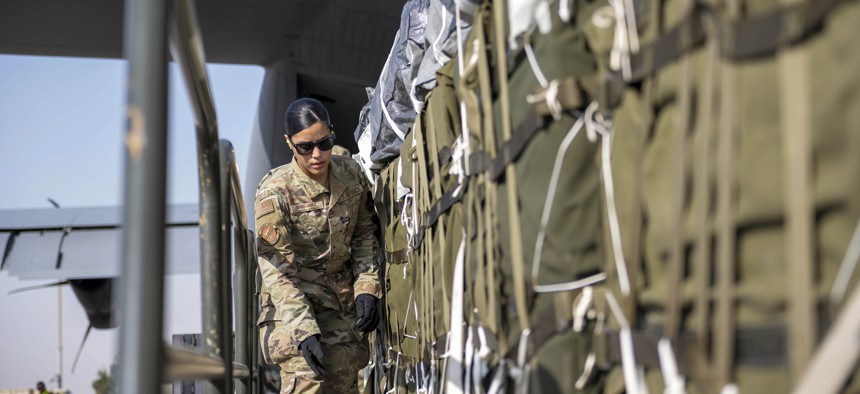
An airman prepares bundles of humanitarian aid for an airdrop over Gaza, March 7, 2024. U.S. Air Force
How to airdrop: A C-17 pilot describes delivering food and water to Gaza
U.S. airlifters get close enough to see the destruction.
Flying above the besieged Gaza Strip on a mission to deliver humanitarian aid, one U.S. Air Force pilot said he could see the conditions on the ground below.
“We see Gaza City. We see destruction. We see people. We know that they're eager to receive aid,” Maj. Jade Crain said in an interview Wednesday.
Crain is a part of an international effort to drop bundles of aid from the air—a method that, while inefficient, may be the only option until additional routes open up to deliver aid to Gaza, which is reaching catastrophic levels of hunger.
“Airdrop may not always be the best answer, but it is a now answer, and it is an effective answer in terms of what we can do to help people,” he said.
The U.S. and other countries have resorted to airdropping food and water into Gaza because the most effective means to deliver aid—ground transport—is obstructed by Israeli restrictions, according to humanitarian organizations. The U.S. is planning to establish a seaport to open up a new avenue for delivery, but that solution could be weeks or months away.
Dropping aid from the air “inherently has an added amount of risk, because you are dropping something from an aircraft. You always risk the chute not deploying or the payload not making it to its intended designee,” Crain said.
Since March 2, the U.S. military has conducted 14 airdrop missions to deliver humanitarian aid to Gaza. Crain has flown all three C-17 missions, on March 13, 15, and 17.
The flights take off and land at Al Udeid Air Base in Qatar, the largest U.S. military base in the Middle East. Crain said his deliveries give him a close-up view of the besieged enclave, and the Palestinian people who desperately need food and water.
The C-17s arrived in the Middle East about two weeks ago, joining the smaller C-130s that handled the initial airdrops. Compared to the prop-driven C-130, the jet-powered C-17 can hold about double the number of pallets, which are filled with Meals Ready to Eat, or MREs, and are halal, in accordance with Islamic dietary rules, Crain said.
Since the beginning of March, the U.S. and Jordanian air forces have dropped more than 300,000 meals and more than 100,000 bottles of water.
Troops at Al Udeid rig the bundles of food, and loadmasters put them onto the cargo plane. After that, an airdrop inspector looks at the load to make sure all the bundles are correctly configured, Crain said.
If a bundle isn’t rigged correctly, it could plummet to the ground, imperiling the people it is meant to help. On March 8, a parachute on an aid package failed to deploy properly and killed five Palestinians, according to reports. CENTCOM later said that was not a U.S. airdrop.
The airdrop inspectors are meant to be a “third party”: fresh eyes to make sure everything is rigged properly, Crain said.
“That's an important part of the airdrop process that we utilize to ensure that all the deliveries will exit the aircraft, safely deploy, and arrive at their target,” he said.
Once the plane is en route and finds the “drop zone,” the C-17 gets the signal to release the bundles through its communications link, Crain said.
“We use our mission computer to help us find, navigate to the exact coordinates of our drop, and those exact coordinates, we take into [account] all the effects from weather, winds are very important, the type of load, how high we are, the direction of our run-in, all those things matter and go into the calculation of when and where to drop,” he said. “We choose points based on the best knowledge that we have to ensure a successful drop, while minimizing to the maximum extent possible any type of risk involved.”
Should the land and sea routes open up, airdrops will likely wind down. But until then, Crain said, they’ll keep delivering aid from the air as long as they’re needed.
“We’ll continue to drop and lend our hand from the C-17 side of things as long as we're asked to, and we’re very happy to continue to lend aid when we can. And it's been very much an honor to be out here throwing our hat in the ring to help these people,” he said.
NEXT STORY: Navy offers 2-option shipbuilding plan
